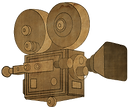top of page

In every film there is another
me
THERE ARE LOADS OF COOKIES BELOW.
PLEASE
REFRESH AT LEAST TWICE
BEFORE SURFING TO ENSURE ALL CONTENT
THERE ARE LOADS OF COOKIES BELOW.
PLEASE
REFRESH AT LEAST TWICE
BEFORE SURFING TO ENSURE ALL CONTENT
CREATIVE CRITICAL REFLECTION
MID-WAY INTERVIEW
Development of Idea
QUESTION 1
How do your products use or challenge conventions and how do they represent social groups or issues?
QUESTION 2
How do the elements in your production work together to create a sense of 'branding'?
In our film, "Gratifly (2018)", the aspects of the logo, its colours and identity, our motifs, and the promotional website combine to create an embodiment of the GRATIFLY brand.

The first element is that of our logo and its colour, where the vibrant palette of light aqua and bright tangerine draws attention and instills the visual identity of the product, Gratifly. This use of light colour (beige, orange, blue) is featured in our production work of our call sheets and story boards, as well as post-production throughout our poster and promotional website.





Other than our visual branding through colour, the recurring motif of the grati-fly is used as a physical embodiment of our brand. Featured as the main antagonist throughout the film, the fly itself makes many appearances through cameos or mentions in our post-production work. With a dedicated fictional storyline of the MEPA Cooperation and its affiliations surrounding the narrative and events seen in the film, this reinforces the presence and importance of the fly where it is simply not a character serving its existence as the mysterious antagonist, but rather a symbol of hinted meaning that represents the wider group of evil conglomerates.
Dedicating a page in the promotional website (post production) solely on the fly's database, as well as a surveillance page that offers the perspective of the Grati-fly's voyeuristic vision of the Boy, we aim to heavily place focus on the importance of the fly as a significant piece to the narrative, but also a physical branding of the film due to its frequent appearances and associations to the film.
The film's theatrical release poster also mentions a climatic scene to which the protagonist battles the fly with a cleaning utensil that is capable of 'spraying all evil'.





QUESTION 3
How do your products engage with the audience and how would they be distributed as real media products?
Moreover, the use of social media as a platform of viral marketing and being consumer-friendly of the new modern and technological age will allow for better connection with the audiences through the employment of hashtags to create twitter trends. Examples would be #gratifly #imnoperfectboy #imwiththefly #windex #MEPA#maskpeople
Or brining engagement to the next level through releasing Twitter and Facebook polls such as...
"WHAT WOULD YOU GIVE TO YOUR DATE THIS VALENTINES DAY?"
[ ] A bottle of Anti-Gratifly
[ ] The Dominant Ideological Pen
[ ] Eggs and breakfast
...which lowers the barriers of entry for more interaction of active audiences beyond the film itself. Role play of the page's administrators on Facebook messenger may be used, where the Unfriended (2014) marketing team had admins reply back to audiences in the role of the possessed account Billie227, or the late Laura Barns - antagonist and ghost. The Gratifly or a MEPA Representative (refer to our film's promotional website to learn more) could reply in its own styles and fashion to engage the audiences with their own personal experience in the shoes of the boy in the film.




Lightly touched upon in the video, the distribution of Gratifly as a real media product would heavily rely on synergy with liquid and cleaning products that are preferably blue, contains a spraying function, and is commonly used by a demographic; housewives, students.
Having Gratifly associated with its key prop (featured on release poster and a climatic key prop for the protagonist), this branding will surely attract unaware consumers to investigate the film with their product of choice, and hopefully pull in new demographics to enjoy this mainstream film.
The pictures attached across each other are rough examples of what they would appear as on the counters of stores, and potentially be sold in the online shop of the Gratifly store.
More details and information on this is in the video above, at 4:46 onwards.

QUESTION 4
How did you integrate technologies - software, hardware and online - in this project?
The creation and creative process of "Gratifly (2018)" in its pre production, production and post were heavily influenced and aided by the presence of technologies.
In the dream team, I was responsible for multiple roles that required many layers and diverse employment of technologies. This was the case, where every production stage called for a different approached, which I tackled using different forms of technologies and integration.
PRE-PRODUCTION
As head writer, director and scriptwriter, I was responsible for crafting and creating the fictional storyline of the film, but to also tailor it towards the dominant ideologies and preferred readings we intended to keep. Doing this required more than paperwork; there were mind-maps, story boards, call sheets, notes, diagrams, and lists.
Being a classic thinker, I decided to express all my thoughts on paper physically, rather than digitally, so there was the practical problem of keeping all the files in one place. Last year in AS we tackled this through having a thought book, which barely kept all the falling pieces of paperwork together for references. However, this year we were dealing with a full-length short film, so more folders would not solve any practical issues. Resorting to an online solution of Google Drive was a great choice: the Team Drive allowed everyone in the cast and crew to store in order and move accordingly any relevant information regarding the film. This also aided our digital meetings through skype, facebook messenger and LINE, where I could ask Toy and Ryu to open the specific document or frame in a story board I was referring to, with the highest quality, and ability to edit simultaneously.
Through the online-based softwares of LINE and Skype, meetings between crew members were significantly easier than having to meet up during school or call via mobile phone which would be costly and time consuming (not knowing when the other person is free, whereas you can set 'statuses' on the software to indicate this easily). Photos, GIF Files, and Media that would have had to be transported by thumb drive or hard drive, could be sent through Facebook Messenger online platform. However, I've realised that the photo quality was not maintained, and photo qualities were broken as sent. Finding a solution to this was the quick change to the LINE software, which had a better quality call system than Facebook's, and fortunately the photos were sent with maintained highest qualities, allowing for clearer inspection of smaller texts in text-dominated documents.

















PRODUCTION
In the time during interval breaks of the shoots, I had used Ryu's secondary camera (CANON 760D) and his 64GB SD card as hardware to capture the behind scenes of the production members. As a production photographer when my director and actor roles are idle, I aimed to provide the crew with content of their work in production to help in their blogs, but as I grew a liking for this side hobby, I found myself using more sources of technology as photographer. I found myself incorporating the hardware of my IPhone 6 camera to take quick snapshots and short videos of the team setting up, Toy's IPhone 5 camera to location scout while Ryu and I were working, and Ryu's IPhone 7 higher quality camera to scan in pre-production paperwork using Cam Scanner Software (iOS) and film short informercials about the film (Todorov's Theory...etc), and finally his 760D to capture fun and professional moments for the blogs and memory.














During shooting, I refer to the storyboard and scanned paperworks of cue sheets to understand the time slot we have, the specific set of sequences or camera angles needed and the locations we have access to. Using the online platform of Google Drive, I was able to quickly review the instructions to continue shooting smoothly. However, after a long day of the shoot, I seldom struggle to keep up with the line of events and frames I have in my memory of what the overall scene should be played out as, therefore the use of iMovie and Adobe Premiere Pro CC 2017 was employed to assemble raw files and produce a rough cut of that section. This has enabled my vision to play out closest to the reality intended, rather than verbal and drawings, and that the dream team will have a better understanding of the wanted mood, cinematography and expression to create.




Therefore, the use of external hardware of cameras allowed for quick capturing of useful information while others were also working to save time of having to go to places or copy out documents individually. The combined online cloud-based storage platform Google Drive's Team Drive allowed for easier access and smoothened operations during filming, and finally the software of Premiere and iMovie aided stylistic and emotional communication between the team to the desired qualities of the final product.
POST-PRODUCTION
After the theoretical and practical process, the focus on officially recording these milestones and journey was done through the online website creator of Wix for my media A2 blog and Gratifly's promotional website: MEPA. Making elements of the website more interesting and interactive, photos and videos of the production were transported manually through use of hard drives as hardware as the files were too big and would take too long to upload on the Team Drive or email. Uploading our short vlogs in the production stage gave a unique approach to the "reflective writing" that would be in the blog or production diary, capturing the feelings, methods, and shots of the scene all in one video through Youtube, an online video uploading website.
Speaking of, I had decided to accompany the text with short moments of the film, but not as dead as a photograph; GIF files. Through the online website of makeagif, giphy, and gifmaker, I had tried out different sites with their individual perks (interactive pen stains, moving animations, and moving and adjustable text) and decorated my text explanations with catchy and interactive GIF files. Also, importing production video clips from Youtube (Ryu's Channel and mine, both as unlisted), I had used youtubetomp4, clipconverter, and converto.io online websites to do so.



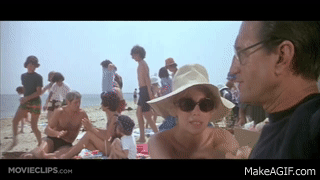

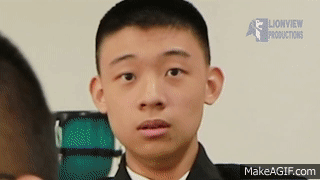
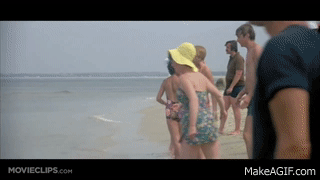
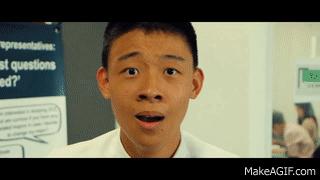






I had concluded that the former website was most effective in least time to convert, highest quality and fewest risk of ads that contain potential spyware or malware.
In post, I had the major responsibility as composer, sound editor and audio artist. Being the creator of the sound aspect of the film's microelements, I had paired up with Ryu to use the Audacity voice recording software on PC, with an inout device of a RODE microphone. Having run a radio show for the school in 2016, I was able to navigate my way through the system's settings and overcame some minor issues such as audio distortion which needed audio cleanup (alike Apple's Logic Pro X). Despite being able to operate the software and record some tracks in sync with the film, it was a while since I have done radio work and the first time in my life to become a folly artist! Needless to say, it took 2 hours on the first day, and another 2 on the next to record all voices needed. This would be an area that I need to focus on developing in media.
Following the recording and being saved, the files were transferred through the hardware of our hard drives to store back ups for insurance. Once the film was superior to its initial rough cut, I had to complete the film by fulfilling the final microelement of sound. I sat down with Ryu to sync and adjust volumes of the audio tracks of the raw files to be louder slightly by dragging upwards the audio level line in each audio file. The music of 'Happy Together' was also reduced by a touch to prevent over powering of music over ambience. Importing snippipts of real life commercials (Shamwow, Orange Clean, AJAX Cleaner, McDonalds), as well as sound effects of TV static and suspenseful chords through youtubetomp4 website, I dragged the audio files into the project in Premiere Pro CC 2017 software and began to layer sound to create the mood of discomfort by audio key framing the files, layering them, and cropping them with the razor tool.
To conclude, I have used a variety of technologies throughout my production to aid communications, capture specific ideas, store and share creative drafts, and create graph and tables that can be beneficial for reference during production and post in editing.
QUESTION 5
How did your production skills develop during throughout this project?
Codes and Conventions - expanded, improved, grown
Throughout the course of the film, as a media consumer and now media producer, I have gradually built, explored, and applied my repertoire of real media texts and inspiration of media sources to the creative process and construction of the film. What could be said as our film's strength for standing out, but also a weakness in terms of audiences involvement due to understanding, is the film's abstract and fictional narrative and plot of events. Also, the audience is largely ambiguous to the mainstream, and not specifying into any target audience or demographic. This makes the film more open to subjective interpretation and the confusing narrative of the fly's social commentary and various visual metaphors. Therefore, to create a sense of comfort and equilibrium for the audiences, many film references and conventions are employed to piece the familiarity with the surrealism together.
Tailoring the film together, I had referenced many films for ideas of scene, such as Saturday Night Fever (1977) where the protagonist makes his way into school happily with a pan up, as well as Face Off (1997)'s Nicholas Cage waltzing his way in with Handel's "Hallelujah", where in this case a direct parody was made to illustrate his elation. Other basis of inspiration also came from Mean Girls (2004), The Hangover II (2011), and The Good, the Bad, and the Ugly (1966).
Eventually, over the course of the film making process, I came to realize the power of using conventions, where it isn't just a tribute to popular culture and real media texts to bear relevance to the modern film era, but can be used as a tool that is arguably more powerful than micro-elements and dialogue. Getting the audience to feel more comfortable, familiar, and understand the plot better with one aspect of reference is beyond belief. I came to appreciate the use of film references for the sake of maintaining the convention of Todorov's equilibrium to give them a sense of comfortability paired with steady editing and smooth cinematography, the influential dolly zoom from Jaws (1975) to accentuate the revelation of discovery in recognition, but the employment of The Good, the Bad, and the Ugly (1966)'s cowboy shoot out questions the stage of repair and makes it unconventional. Therefore, using media text references carefully, and pairing with application of Todorov's Narrative theory which we mostly give in to conventions, the storyline becomes clearer and strengthens the structure of the film.
Another convention I touched upon is the code of the genre; comedy-drama. Researching into the main aspects of comedy, I had decided to apply the two conventional aspects of pregnant pause and comic timing to highlight big moments of the first disruption by the fly (comic timing), and the dolly zoom moment of the boy's revelation (pregnant pause). Not using slapstick was a choice carefully considered, as excessive violence would be hard to execute and edit. The implied and hinted sense of threat and vulnerability is what we were aiming for to undermine the fly's presence as the dangerous society that seeps through unpredictability. So, rejecting a conventional form of comedy genre not only makes out film majorly comedy (2 of 3), but also expands more fields into character development of the antagonist and meaning.
Reflecting on last year's AS coursework, the intention of conventions were only limited to film references, and nothing beyond that to create meaning, improve audience interactions, and improve storyline and character development. However, this year I have grown to a higher level of awareness and understanding of conventions and codes which is touched on the genre, the narrative, and the films have been used to created a more interactive and audience-friendly experience.
Planning and Organisation - strict, concise, strategic
Having major multi-roles in all stages of production; head writer and story boarder in the pre; director and actor in production; folly artist, composer, audio mixer and executive producer in post: I have to compile between large amounts of paperwork, negotiations of shoot times with other crews' priorities, booking and emailing for props and additional requirements for instance.
Last year in AS, we had a 'thought book' that barely managed to fit in all the compressed and unordered paperwork and files, which made reference of specific pages difficult and time consuming. This year, I decided to find a sustainable, accessible, and non practical way to store files in large quantities through online platforms. Google drive's "Team Drive" allowed for a team collaboration on documents anywhere; changes of location or script dialogue the morning before, during shooting, and corrections in post. This shift to online has improved management and organisation of files, which massively aided communications between me as the director and the cinematographer.
Speaking of which, initially we were going with Facebook messenger as a way to communicate production times and transfer files, however I had suggested the swap to LINE software to uphold image quality for professional and accurate uploads which proved to be an effective decision.
The challenges of early mornings, late afternoons, and frequent location changes of each scene has taught me to become more strict, reliable and honest with my planning. Every day before a shoot, I would create a hand-drawn list or sketch of a story board, and digitally distribute it through the online chat groups (LINE and Facebook Messenger) to the crew. This ensured everyone knew what was happening where and when. I had also developed my email etiquette and learnt some skills on the Outlook Application to send polite emails to book equipment, but also to digitally schedule events, and even marked some emails as "Highly Important".
Cinematography - aware, sensitive, understadning
Although I am not the cinematographer, I have had my fair share of camera experience from being a photographer on set, as well as the director in which my vision should correlate to what is shown, portrayed by the camera. My awareness of camera angles to use has increased from research of unique camera angles from films and information sheets. As the film is a fictional and surrealistic one, cinematography was an important aspect I focused on to capture meaning, tailor the narrative, and imply character development and style from their portrayal. This is in contrast to my days in AS Media, in which the cinematography was not seen by me as bearing much importance except keeping the 180 degree rule, using conventional and predictable canted angles, and the sense of using them to keep interest from a single boring shot. Therefore, my higher level of awareness in cinematography has allowed me to become more sensitive in my approach as director to use cinematography as a tool for meaning and the 'glue' of the narrative.
Also, now having been more experienced with cameras and having the chance to use a 760D, I became an active learner and opened up to techniques and tips from Ryu on using the camera, manual and auto focus, ISO basics, and the lighting manipulation available from scrolling. This would come to aid my personal preferences of blocking the composition of a scene.
Editing
Editing was never my forte since AS Media. However, between then and GRATIFLY, I have had the chance to edit many sorts of projects (vlogs, fun videos, official professionals for the school, comedy skits, and a music video). This rare opportunity has taught me an incredible amount of knowledge and detail of using premiere, as well as improving my originally unclear understanding and liking of the editing process. Learning techniques of key framing, layering, colour grading (something I have never touched or cared for, but had to learn for a disco video I was editing- which made me appreciate the power of colour and its tone meaning, alike the micro elements, to the whole film), and the underrated but sublime warp stabiliser. Recently, I had learnt through the web on how to create a "shaking" or "earthquake motion" manually in post on premiere, using the directional blur aspect which I did not know was possible, but was elated to find.
From last year onwards, I have been very fortunate to have had many roles and leadership positions related to media and editing projects of many genres, allowing me to explore the techniques I know of, and seeing what works well with which type. In addition, I am now inseparable from the key framing of scale and position technique; it is now my signature must-have in all videos I edit. So, editing has not only grown my knowledge of techniques to use, but also shaped me as a media producer of the editing role.
Relating to Gratifly, this proliferation of experience has allowed communications and my explanation of desired sequences to the cinematographer easier and more accurate, as we can both understand the same language and envision accurately with specific mentions to key terms that I would have ignored, dismissed or simply accept to avoid time consumption of the conversation in last year's coursework production. Now being able to grasp editing's techniques, able to apply them in real media projects, and appreciate the job of the editor, it is safe to say that my editing skills and awareness have equally improved to higher extents and are beneficial to production stages of storyboarding, cue sheets and discussion that require editing visions or terms.
MEDIA A2
bottom of page
